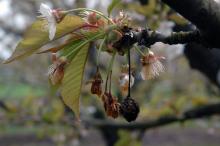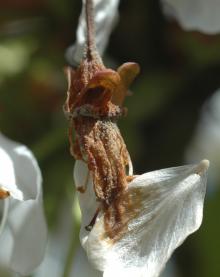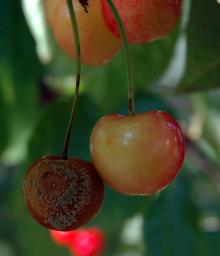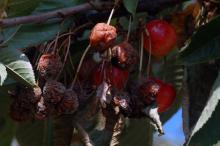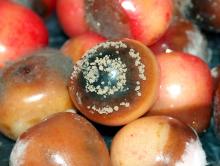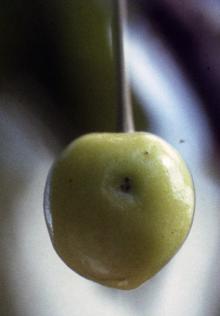Cause The fungi Monilinia fructicola and M. laxa can incite a blossom blight, a twig and branch dieback, and a fruit rot of several Prunus spp. including many ornamental and fruit trees. Fungi survive year to year on infected twigs, branches, old flower parts, or mummified fruit. Conidia are produced on infected plant debris in the tree when the temperature is above 40°F. A small, mushroom-like structure (apothecium) can be produced on fruit that drops to the ground. Wind and rain blow spores (conidia and ascospores) to healthy blossoms in spring to begin the infection process during wet weather. Infection does not occur below 50°F and will occur for M. laxa above 55°F. Flowers can be blighted any time floral tissue is exposed but are most susceptible at full bloom. More spores can be produced on this tissue, initiating several more disease cycles during the spring. Under severe conditions, non-flowering shoots or leaves can be infected directly.
Some infections may be symptomless until fruit begins to ripen. The risk of these latent infections is highest from bloom through pit hardening, declines to a low risk at embryo growth then begins to increase as fruit ripen. Ripening fruit are highly susceptible to infection, and more disease cycles can occur near harvest. Peach, nectarine, and prune fruit that fall to the ground due to lack of pollination, thinning, or overripeness can significantly increase inoculum and the amount of fruit rot at harvest. Fruit infected in the orchard may not show symptoms until it is in storage or transit. High nitrogen fertilization also is associated with increased levels of brown rot.
Both fruiting and ornamental cherries, peaches, nectarines, prunes, plums, almonds, and apricots are susceptible. Pome fruit, including quince, can be susceptible under high disease pressure years. The disease is more of a problem west of the Cascade Range. Surveys of eastern Washington packinghouses during 2000 and 2001 found very little brown rot on peaches and nectarines.
Symptoms Infected flower parts turn light brown and may develop areas of buff-color (M. fructicola) or gray (M. laxa) spores. Infected petals may look water soaked, which can be mistaken for frost injury. Flowers generally collapse as the fungus invades through the pedicel. Infected flowers often adhere to twigs and spurs through harvest or even winter.
Depending on the fungus and plant infected, the disease may continue into twigs or spurs. Lesions may remain discrete or girdle the twig, causing all distal portions to die. Profuse gumming also may occur in these areas. Again, buff or gray spores (in sporodochia) may develop on these necrotic twigs.
Fruit symptoms begin as small, dark spots that enlarge rapidly. Fruit remains fairly firm and dry relative to a watery rot caused by Rhizopus sp. Production of masses of buff-color spores is equally rapid in the necrotic area. Peaches may have concentric rings of gray sporulation (in response to light) as the rot takes a few days to encompass the entire fruit. These fungi often colonize rain-cracked cherries. Occasionally, green fruit pitting has been attributed to this fungus as it can be detected in small necrotic area at the bottom of the depression in the skin.
Cultural control These must be supplemented by chemical methods especially in the wettest areas such as west of the Cascade Range.
- Remove and destroy infected twigs and branches in summer.
- Shorten large trees and prune out shaded limbs in summer for a more open canopy that dries out quickly.
- Remove and destroy all mummified fruit in and around the tree. Cultivating or burying old fruit before the growing season will not reduce the risk of this disease. However, removing fallen fruit (due to thinning or lack of pollination) can significantly reduce the amount of rot at harvest.
- Control insects that could wound and injure fruit.
- Avoid wounding fruit during harvest.
- Cool fruit rapidly after harvest.
- Use moderate amounts of nitrogen fertilizer.
- A short (2.5 min) soak in hot water (122°F) has reduced postharvest decay in nectarines and peaches. Some additives have increased efficacy of this treatment. Microwaves used to increase fruit temperature for a short period have also been successful.
Chemical control Apply fungicides during the bloom period at early popcorn (red bud, pink bud, or green tip, depending on crop), full bloom, and/or petal fall to control the blossom blight phase. In California and Oregon, one or two sprays are sufficient most years if a product with systemic (translaminar) activity is used. Fruit-rot sprays can be applied before harvest if wet weather is expected. To reduce the possibility of resistant fungal strains, alternate or tank-mix fungicides from different groups that have different modes of action. Also, limit applications from any particular group to two (2) or fewer per year. Selection of products for rotation and/or mixing must consider group 7 fungicides when used through the irrigation as a nematicide. Resistance to group 3 fungicides has been detected in eastern states.
- Abound at 12 to 15.5 fl oz/A. Do not apply with silicone-based surfactants. May be applied the day of harvest. Sprayers used for Abound should not be used on apples. Group 11 fungicide. 4-hr reentry.
- Bonide Captan 50 WP may be used in home gardens at 1 to 1.5 Tbsp/gal water. Washington only. H
- Bravo Weather Stik at 3.1 to 4.1 pints/A, for blossom blight only. Do not apply after shuck split. Avoid use when honey bees are active due to larval toxicity. Group M5 fungicide. 12-hr reentry.
- Cabrio EG at 9.5 oz/A. For Cherry only. May be used at harvest. Group 11 fungicide. 12-hr reentry.
- Captan 80 WDG at 1.9 to 2.5 lb/A for cherries, 1.9 to 3 lb/A for apricots, 2.5 to 3.75 lb/A for prunes and plums, 2.5 to 5 lb/A for peaches. Applications may be made day of harvest. Generally good control. Not recommended due to concerns about pollinator brood development. Group M4 fungicide. 24-hr reentry.
- CaptEvate 68 WDG at 3.75 lb/A. Can be used day of harvest. For Cherry only. Not recommended due to concerns about pollinator brood development. Group 17 + M4 fungicide. 24-hr reentry.
- Cevya at 3 to 5 fl oz/A. May be used day of harvest. Group 3 fungicide. 12-hr reentry.
- Cinnerate at 16 to 64 fl oz/100 gal water plus an adjuvant. 4-hr reentry. O
- Eagle 20 EW at 2 to 3 fl oz/100 gal water for home orchards or landscape use. Can be applied up to the day of harvest. Group 3 fungicide. 24-hr reentry.
- Echo 720 at 3.1 to 4.1 pints/A, for blossom blight only. Do not apply after shuck split. Avoid use when honey bees are active due to larval toxicity. Group M5 fungicide. 12-hr reentry.
- EcoSwing at 1.5 to 2 pints/A. Can be used day of harvest. Fair control. Group BM01 fungicide. 4-hr reentry. O
- Elevate 50 WDG at 1 to 1.5 lb/A (use higher rates when used alone). Applications may be made up to and including the day of harvest. Group 17 fungicide. 12-hr reentry.
- Fixed copper, for blossom blight only. Do not use after full bloom. Rated with low control. May only encourage resistant bacterial pathogens. Avoid use when honey bees are active due to bee toxicity. Group M1 fungicides. O
- Bonide Copper Fungicide at 4.3 to 13 oz/3 to 9 gal water. Group M1 fungicide. H
- Champ Dry Prill at 4 lb/A. 48-hr reentry.
- C-O-C-S WDG at 1 to 2.9 lb/A. 48-hr reentry.
- Cueva at 0.5 to 1 gal/100 gal water/A. May be used on day of harvest. 4-hr reentry.
- Cuprofix Ultra 40 Disperss at 3.75 lb/A. 48-hr reentry.
- Kocide 3000 at 3.5 to 5 lb/A. 48-hr reentry.
- Monterey Liqui-Cop at 2 to 3 teaspoons/gal water.
- Nu-Cop 50 DF at 2 to 3 lb/A. 48-hr reentry.
- Previsto at 2 to 4 quarts/A. Do not mix with any other materials. 48-hr reentry.
- Fontelis at 14 to 20 fl oz/A. Can be used day of harvest. Group 7 fungicide. 12-hr reentry.
- Indar 2F at 6 fl oz/A plus a wetting agent. May be applied up to day of harvest. Generally excellent control. Group 3 fungicide. 12-hr reentry.
- Inspire at 7 fl oz/A. May be used day of harvest. Group 3 fungicide. 12-hr reentry.
- Inspire Super at 16 to 20 fl oz/A. Tart Cherry only. Do not apply within 2 days of harvest. Group 3 + 9 fungicide. 12-hr reentry.
- Iprodione-based products. Do not apply after petal fall or more than two (2) times per season. Generally good control if resistance is not a problem. Do not mix with insecticides due to honey bee adult and/or larval toxicity. Group 2 fungicides. 24-hr reentry.
- Iprodione 4L AG at 1 to 2 pints/A.
- Meteor at 1 to 2 pints/A.
- Rovral 4 Flowable at 1 to 2 pints/A.
- Kenja 400 SC at 12.5 fl oz/A. Do not use within 1 days of harvest. Group 7 fungicide. 12-hr reentry.
- Luna Experience at 6 to 10 fl oz/A. May be used day of harvest. Group 3 + 7 fungicide. 12-hr reentry.
- Luna Sensation at 5 to 7.6 fl oz/A. Do not use within 1 day of harvest. Do not use for brown rot if planning to use for powdery mildew. Group 7 + 11 fungicide. 12-hr reentry.
- Merivon at 4 to 6.7 fl oz/A. Do not use with EC or oil-based products. Only nonionic surfactants can be used within 14 days of harvest. May be used day of harvest. Do not use for brown rot if planning to use for powdery mildew. Group 7 + 11 fungicide. 12-hr reentry.
- Miravis at 5.1 fl oz/A. Can be used up to the day of harvest. Group 7 fungicide. 12-hr reentry.
- Miravis Duo at 13.6 fl oz/A. Can be used up to the day of harvest. Group 3 + 7 fungicide. 12-hr reentry.
- Myclotect at 2 to 3 fl oz/100 gal water plus spreading agent. Can be used for home orchards or landscape use. May observe a PGR effect. Do not use within 14 days of harvest. Group 3 fungicide. 24-hr reentry.
- Ortho MAX Garden Disease Control at 3.75 teaspoons/4 gal water. H
- Oso SC at 6.5 to 13 fl oz/A. May be applied on the day of harvest. Group 19 fungicide. 4-hr reentry O
- Pristine at 10.5 to 14.5 oz/A. Can be used day of harvest. Do not use for brown rot if planning to use for powdery mildew. Group 7 and 11 fungicide. 12-hr reentry.
- Problad Verde at 18.1 to 45.7 fl oz/A. Reapply if rain occurs within 12 hours of original application. Do not use within one day of harvest. Group BM01 fungicide. 4-hr reentry.
- Procure 480 SC at 10 to 16 fl oz/A. For Cherry Only. Do not apply within 1 day of harvest. Good to excellent control. Group 3 fungicide. 12-hr reentry.
- Propiconazole-based fungicides are registered. Limited to two (2) applications. Smaller, deeper green leaves and smaller fruit have been measured on trees treated multiple times during the growing season. Do not mix with insecticides due to bee toxicity. Group 3 fungicides.
- Bumper 41.8 EC at 4 fl oz/A. May be used up to and including day of harvest. Do not use on Stanley-type Plums. 12-hr reentry.
- Infuse Systemic Disease Control at 2 Tbsp/gal water. H
- PropiMax EC at 4 fl oz/A. Do not use within 10 days of harvest. Do not use on Stanley-type Plums earlier than 21 days before harvest. 12-hr reentry.
- Tilt at 4 fl oz/A. May be used up to and including day of harvest. Do not use on Stanley-type Plums earlier than 21 days before harvest or mix with Syllit. 24-hr reentry.
- Quadris at 12 to 15.5 fl oz/A. May be applied the day of harvest. Sprayers used for Abound should not be used on apples. Group 11 fungicide. 4-hr reentry.
- Quash at 2.5 to 4 oz/A. Do not make more than three (3) applications/year or within 14 days of harvest. Group 3 fungicide. 12-hr reentry.
- Quadris Top at 12 to 14 fl oz/A. May be applied on the day of harvest. Sprayers should not be used on apples. Do not mix with insecticides due to bee toxicity. Group 3 + 11 fungicide. 12-hr reentry.
- QuiltXcel at 14 fl oz/A. May be applied the day of harvest. Do not use on Stanley-type Plums earlier than 21 days before harvest. Sprayers should not be used on apples. Group 3 + 11 fungicide. 12-hr reentry.
- Rally 40 WSP at 2.5 to 6 oz/A. Can be applied up to the day of harvest. Generally fair to good control. Group 3 fungicide. 24-hr reentry.
- Rhyme at 7 fl oz/A. Do not use within 7 days of harvest. Group 3 fungicide. 12-hr reentry.
- Spectracide Immunox Multi-Purpose Fungicide Spray Concentrate for Gardens at 0.5 fl oz/gal water. Can be applied up to and including the day of harvest. Do not use more than seven (7) times per year. Group 3 fungicide. H
- Sulfur-based products have good efficacy during bloom for blossom blight control but are not as useful for fruit rot. Do not use within 2 weeks of an oil spray. Group M2 fungicides. 24-hr reentry. O
- Bonide Sulfur Plant Fungicide (90% wettable) at 1 to 3 Tbsp/gal water. H
- Microthiol Disperss (80% sulfur) at 10 to 20 lb/A.
- Sulfur 6L (52% sulfur) at 5 gal/A.
- Thiolux (80% sulfur) at 10 to 30 lb/A.
- Tebuconazole-based products can be applied up to and including day of harvest. Generally good to excellent control. Group 3 fungicides.
- Tebucon 45 DF at 4 to 8 oz/A. 5-day reentry.
- Tesaris at 3.5 to 5.6 fl oz/A. Do not use with oil-based products. May be used day of harvest. Group 7 fungicide. 12-hr reentry.
- Topguard SC at 14 fl oz/A. Do not use within 7 days of harvest. Group 3 fungicide. 12-hr reentry.
- Topguard EQ at 6 to 8 fl oz/A. Do not use with silicone surfactants or within 7 days of harvest. Sprayers should not be used on apples. Group 3 + 11 fungicide. 12-hr reentry.
- Topsin 4.5 FL at 20 to 30 fl oz/A plus another fungicide. Do not apply within 1 day of harvest. Group 1 fungicide. 2-day reentry.
- Trionic 4 SC at 10 to 16 fl oz/A. For Cherry Only. Do not apply within 1 day of harvest. Good to excellent control. Group 3 fungicide. 12-hr reentry.
- Vangard WG at 5 oz/A plus another fungicide. For blossom blight only on apricots, tart cherries only, nectarines, peaches, plums, and prunes. Not registered for sweet cherry. Do not use with X-77. Group 9 fungicide. 12-hr reentry.
- Wettable sulfur (92%) at 5 to 10 lb/100 gal water. Not for apricot or recommended during bloom west of Cascade Range. Group M2 fungicide. 24-hr reentry. H O
- Ziram 76 DF at 6 to 8 lb/A for apricots, at 5 to 6 lb/A for cherries or at 6 lb/A for peaches. Do not apply within 30 days of harvest. Generally, gives slight control. Avoid use when honey bees are active due to larval toxicity. Group M3 fungicide. 48-hr reentry.
Note Some registered products offer only suppression of this disease and thus are not recommended for use. These products include Dodine, Double Nickel 55, Flint Extra, and Syllit.
Biological control
- Botector (Aureobasidium pullulans strains DSM 14940 and 14941) at 6 to 14 oz/A depending on water volume. Can be applied day of harvest. Compatible with sulfurs, oils and a few fungicides but not with many synthetic fungicides. Was not effective in one western Oregon test on blossom blight. 4-hr reentry. O
- BotryStop (Urocladium oudemansii U3 strain) at 2 to 4 lb/A. Keep refrigerated before use. Compatible with many wetting agents, some fungicides and biologicals but not all. Unknown efficacy in the PNW. 4-hr reentry. O
- Howler Evo (Pseudomonas chlororaphis strain AFS009) at 20 to 120 oz /A plus a surfactant. Can be used day of harvest. 4-hr reentry. O
- Serenade OPTI (Bacillus subtilis strain QST 713) at 14 to 20 oz /A. Active ingredient is a small protein. Use only for blossom blight during bloom. 4-hr reentry. O
- Serenade Garden Disease Control Concentrate at 2 to 4 fl oz/gal water. Use only for blossom blight during bloom. H O
References Biggs, A.R. and Northover., J. 1988. Influence of temperature and wetness duration on infection of peach and sweet cherry fruits by Monilinia fructicola. Phytopathology 78:1352-1356.
Holb, I.J. and Schnabel, G. 2005. Effect of fungicide treatments and sanitation practices on brown rot blossom blight incidence, phytotoxicity, and yield of organic sour cherry production. Plant Disease 89:1164-1170.


